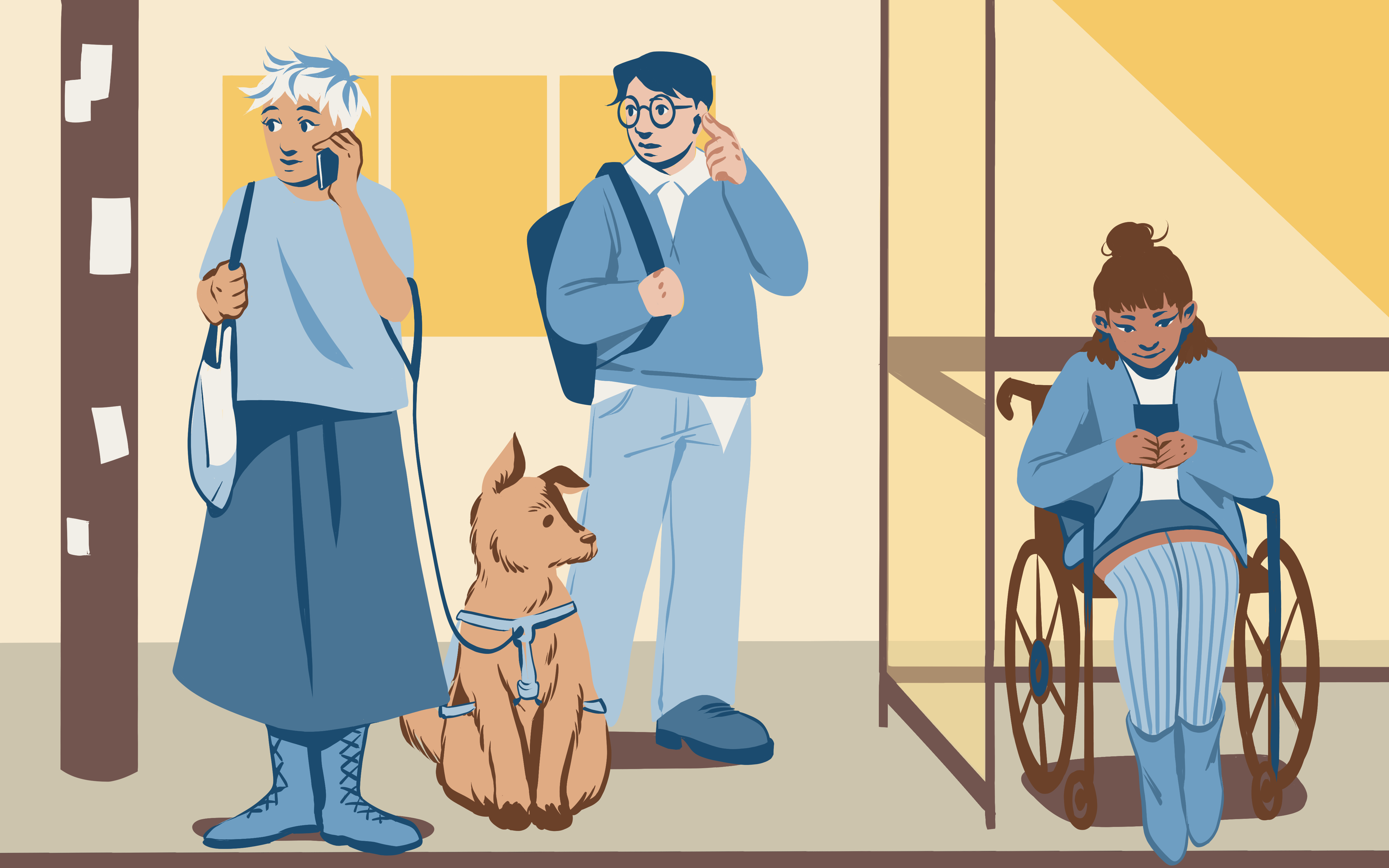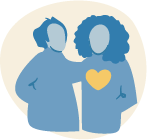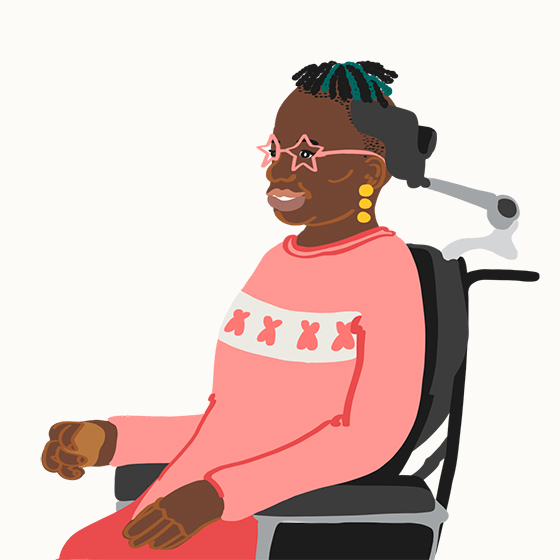People with disabilities
Considerations for disabled people navigating gender-affirming care.

This page is a resource for disabled trans, Two-Spirit A term used within some Indigenous communities to reflect complex Indigenous understandings of gender and sexuality and the long history of sexual and gender diversity in Indigenous cultures. Two-Spirit encompasses sexual, gender, cultural and spiritual identity. It may refer to cross-gender, multi-gender or non-binary gender roles, non-heterosexual identities, and a range of cultural identities, roles and practices embodied by Two-Spirit peoples. Some people also use "2-Spirit" or "2S." (Source: Battered Women’s Support Services) , and non-binary Umbrella term referring to people whose gender does not fall within the binary gender system of woman/girl or man/boy. Some individuals identify as non-binary while others may use terms such as gender non-conforming, genderqueer, or agender. Non-binary people may or may not conform to societal expectations for their gender expression and gender role, and they may or may not seek gender-affirming medical or surgical care. people. This includes those of us whose disabilities are visible or invisible, clinically diagnosed or undiagnosed.
While not all the information on this page will be relevant to every person, we hope it will help you to set your expectations and feel better prepared to navigate your gender journey.
Are you neurodivergent?
If you are interested in more resources for people who identify as neurodivergent, please visit our page for Neurodivergent People.
Non-medical gender affirmation
There are two main approaches to gender affirmation The ways a person can be supported in expressing their self-identified gender. This may involve supporting social transition steps or changes in gender expression. :
- non-medical gender affirmation (sometimes called social transition), and
- gender-affirming health care (which includes hormone therapy and surgery).
Social transition
The Explore & Transition section of our website is written to help you understand the transition journey and available options.
Exploring your gender
Changing your gender expression
Each person must make their own decisions about the safety of binding Wearing compression garments or using other methods to flatten the chest. or tucking Method of positioning the penis and testicles so as to conceal them. . Binding or tucking may worsen some health problems such as chronic skin conditions, chronic pain or breathing problems.
Your health care provider may suggest ways to increase the safety for you. For example, they might suggest using a looser binder or reducing the number of hours you tuck for. Depending on your situation, they may even recommend you avoid the practice temporarily or permanently.
If this is the case, ask your provider about alternatives. For example, if you cannot tuck due to a chronic skin condition, orchiectomy A gender-affirming lower surgery to remove the testicles. might be an option for you.
Contact our team of experienced health navigators for information about gender-affirming care in B.C.
Self-advocacy
Those of us with disabilities are already familiar with having to advocate for ourselves within the health care system before we start our gender-affirming care Processes through which a health care system cares for and supports an individual while recognizing and acknowledging their gender and expression. journey. We can draw on these skills to help ourselves as we seek care.
Some disabilities and health conditions will significantly impact the gender-affirming care options available, but in many cases, disabled people can access hormones and surgery, even if additional care planning Process that a person, their health care providers, family and other supporters undertake in planning to reach their gender-affirming care goals. or support is needed.
Thinking about your goals
Going into a conversation with a provider, it can help to think about your goals for that appointment in advance. You can do research to identify possible issues that may be raised by the health care provider, as well as considerations they may not be aware of but that are relevant to your situation. This can help you feel more prepared.
For example, if you use a manual wheelchair and you are seeking top surgery Refers to some gender-affirming above-the-waist surgeries, including chest surgeries and breast surgeries. , you will likely need a power chair while healing. You might speak with your primary care provider A person’s main health care provider in non-emergency situations such as check-ups and referrals. Family doctors, general practitioners (GPs) and nurse practitioners (NPs) are all primary care providers. about this so they can support you to connect with appropriate allied health professionals, such as an occupational therapist, to set up a short term rental option.
Talking with your health care provider
During your care journey, there may be some hard conversations about interventions that are not recommended or available for you. A surgeon or prescribing clinician should be able to explain the reasoning for their recommendations or decisions, and you have a right to this explanation and to have your questions answered. Try to listen to the provider's perspective and understand the concerns they might bring up regarding safety and risk.
If any issues identified in the consult require more problem-solving, request a follow-up meeting. Speak with other members of your health team and ask for their assistance with addressing the concerns raised. Consider bringing another person to help advocate for you, or even just to take notes and witness the conversation.
For more information, see our page Speaking to your provider.
Readiness assessments
If you're thinking about hormone therapy or surgery, one of the first steps is a readiness assessment An evaluation conducted by a health care professional to determine if a patient is ready to begin hormone therapy or have gender-affirming surgery. . This is a conversation with a health care provider about your goals and what you hope to achieve through hormone therapy or surgery. This is the case for everyone in BC, whether or not they are disabled.
What happens during a readiness assessment?
During a readiness assessment, a provider will ask about a person’s goals, look at the support systems they have in place and assess a person’s capacity to consent to care. They will determine that the person seeking care is informed, capable of making decisions, and acting voluntarily (without coercion.)
To prepare for this conversation, you might ask yourself questions such as:
What effects am I hoping for from this treatment?
Are there changes that I would prefer to avoid?
If this treatment doesn’t work as I hope, what might I do?
Can people with intellectual or developmental disabilities consent to care?
During a readiness assessment An evaluation conducted by a health care professional to determine if a patient is ready to begin hormone therapy or have gender-affirming surgery. , health care providers make judgements based on each person’s unique circumstances, including their support systems and their ability to understand and express their own gender goals.
Individuals with intellectual or developmental disabilities can also be trans. Many people with intellectual or developmental disabilities access hormone therapy or gender-affirming surgery, similar to accessing any other necessary medical or surgical care. Whether or not a person accesses gender-affirming health care, a supportive environment helps make space for gender autonomy.
More information on readiness assessments
For more information about the readiness assessment process, see our page on How to start hormone therapy or explore pathways for Surgery.
Hormones
Hormone therapy is well tolerated by most people. Health care providers assess the safety of hormone therapy on an individual basis.
Health conditions and hormone therapy
Some health conditions are known to increase risks associated with hormone therapy. These conditions include unstable heart disease, severe liver disease and hormone-sensitive cancer. If you have one of these health conditions, you may wish to begin or continue hormone therapy in spite of higher risk. It’s important to consider your overall quality of life and determine your priorities.
Modifications to hormone therapy may be recommended to increase safety. This could involve using:
- a different formulation (e.g., patch instead of pill),
- a lower dose,
- or avoiding certain medications.
Interactions between medications
Serious interactions between hormone therapy and other medications are uncommon. Sometimes, treatment may need to be monitored more closely or modified because of other medications you’re taking. Sometimes, a medication that you are already taking can be switched to an alternative to make starting hormone therapy safer.
I can’t self-administer injections. What are my options?
If you are taking an injectable form of hormones but cannot self-administer injections due to your disability, your health care provider may suggest an alternative to injectable medication such as gel. You may be eligible for special authority pharmaceutical coverage to lessen the cost.
Injections could also be administered by another person. Some options may include a friend or family member, nurse or doctor, or some pharmacists.
If hormone therapy cannot be used due to safety issues, other options for gender affirmation The ways a person can be supported in expressing their self-identified gender. This may involve supporting social transition steps or changes in gender expression. may be possible.

Non-medical gender affirmation is an option
Visit Explore & Transition for more information on non-medical options for altering your gender expression How a person outwardly communicates their gender, including name and pronoun choice, style of dress, and voice modulation. (Source: QMUNITY) .

Some surgeries may be an option
For example, breast surgery may be a safer option than estrogen for some people.
Surgery
Many disabled people access gender-affirming surgery. Typically, health care providers will assess the safety of surgery on an individual basis.
Care planning
Care planning Process that a person, their health care providers, family and other supporters undertake in planning to reach their gender-affirming care goals. includes all of the preparations made by yourself, your care team, and your care networks to ensure you’re prepared before surgery and well supported while recovering. This preparation includes arranging rides to and from the hospital, gathering meals and supplies for the time after surgery, and knowing where to go to get help if you have concerns after surgery. This process is necessary for everyone, but is especially important for people with disabilities, as we may require more support, including potentially longer recovery times.
The Surgery section of the Trans Care BC website has tips for developing a specific self-care plan for each of the gender-affirming surgeries funded by MSP The Medical Services Plan (MSP) is a B.C. government health plan that pays for physician services and referred services that are considered medically necessary, such as specialists (surgeon, psychiatrist, etc.), diagnostic x-rays, or laboratory services, for all BC residents. Some residents qualify for premium assistance for physiotherapy, chiropractic, naturopathy, massage therapy and acupuncture. .
Addressing risk factors
If the surgeon determines that you have elevated surgical risk factors, they may ask you to do certain things to improve your health before scheduling a surgery.
- This may include seeing a specialist to better manage a chronic health condition, stopping nicotine use or losing some weight.
- Your surgeon may also recommend an alternative procedure than the one you had hoped for, because they feel it’s a safer option for you.
There are situations where surgeons may feel there is no way that a particular surgery can be safely provided. This can be very difficult to hear and accept. Your health care team can support you and connect you with resources to help you cope with this loss. They can also help you consider non-surgical options for gender-affirmation.
Higher body weight may increase some surgical risks, and surgeons take a patient’s weight into account when they consider eligibility for surgery.
- The surgeon may ask you to do additional tests to better assess the safety of surgery. For example, they may ask you to test for sleep apnea.
- The surgeon may also request a consult with an anesthesiologist to better assess the safety of surgery for you.
- To increase safety, the surgeon may decide that your surgery should take place in a hospital facility rather than an outpatient facility, which may increase the wait for surgery.
The surgeon may ultimately ask you to lose some weight. Your primary care provider A person’s main health care provider in non-emergency situations such as check-ups and referrals. Family doctors, general practitioners (GPs) and nurse practitioners (NPs) are all primary care providers. can support you with options to help you achieve weight loss, if desired.
You may want to ask about the possibility of a second opinion if the surgeon is unable to do the surgery you are hoping for based on your BMI. Different surgeons and the facilities they work in may have different BMI requirements, depending on the surgery.
Support systems & caregivers
Working with caregivers
Many disabled people rely on caregivers to help with daily living, including activities related to gender affirmation The ways a person can be supported in expressing their self-identified gender. This may involve supporting social transition steps or changes in gender expression. . Your caregiver may not have supported trans people before. If they are open to it, you could share resources like Making mistakes and correcting them or Intro to Gender Diversity.
You may wish to plan for private discussions with your health care provider if your caregiver is usually present during medical appointments. It may be helpful to communicate with your caregiver or provider about this ahead of time.
If your caregiver is employed by a larger organization and is not willing to help you meet your gender care needs, you may be able to appeal to other people in the organization on the basis that you are receiving inadequate care.
At times, it may be helpful to bring in additional advocates.
Additional advocates

Your primary care provider
Your primary care provider A person’s main health care provider in non-emergency situations such as check-ups and referrals. Family doctors, general practitioners (GPs) and nurse practitioners (NPs) are all primary care providers. , if you have one, can be a resource in this situation. They can advocate for the care that you need, emphasize the medical necessity of this care and provide education.

Trusted friends and family
Trusted friends and family members may be able to help communicate about your needs on your behalf.

Community care networks
Community care networks can help you connect with other potential advocates. This includes non-profit organizations and community clinics as well as informal peer networks or social media groups.
Connecting with support
Advocacy organizations like LET’S or Disability Alliance BC can offer resources and assistance as you navigate the health care system. This could look like help completing forms, understanding your options, or getting documentation from other practitioners.
Connecting with a peer support group made up of others who understand your experiences can help with feelings of loneliness and provide useful advice.
Chronically Queer — A peer support group for 2SLBGTQIA+ people who are neurodivergent, mad, crip, chronically ill, and/or disabled.
Queerabilities — A lightly moderated weekly check-in for folks in the 2SLGBTQIA+ community who live with mental or physical disabilities or chronic illnesses, or otherwise identify as disabled, regardless of a formal diagnosis.
Trans Care BC’s Peer Support Directory contains other groups and services throughout B.C. for trans, non-binary Umbrella term referring to people whose gender does not fall within the binary gender system of woman/girl or man/boy. Some individuals identify as non-binary while others may use terms such as gender non-conforming, genderqueer, or agender. Non-binary people may or may not conform to societal expectations for their gender expression and gender role, and they may or may not seek gender-affirming medical or surgical care. and Two-Spirit A term used within some Indigenous communities to reflect complex Indigenous understandings of gender and sexuality and the long history of sexual and gender diversity in Indigenous cultures. Two-Spirit encompasses sexual, gender, cultural and spiritual identity. It may refer to cross-gender, multi-gender or non-binary gender roles, non-heterosexual identities, and a range of cultural identities, roles and practices embodied by Two-Spirit peoples. Some people also use "2-Spirit" or "2S." (Source: Battered Women’s Support Services) individuals.
There are also many Facebook groups, Discord servers and other online communities for disabled trans people where you may be able to find advice and support.
Resources for disabled trans people
Below is an evolving list of resources, and we welcome your input. If you have any resource recommendations you think are helpful, please contact us.
- Disability Alliance BC — This group provides services and resources that support people with all types of disabilities.
- Foundry — This organization is a network of integrated health and wellness services, tools, and information for those ages 12–24.
- Sex Ed for People with I/DD: This resource from the National Council on Independent Living (USA) is developed by and for people with intellectual/developmental disabilities to support conversations about sexual and reproductive health. It includes videos on sex, gender, genitals, and puberty.
- Exile and Pride by Eli Clare — This book features personal essays exploring the intersections of disability, trans experience, and community organizing.
Community Voices

Having a disability can complicate the process of medical transition, but it can also be a source of strength. Disabled people have experience advocating for ourselves, navigating complex medical systems, and recognizing new needs that our bodies develop. When we transition, our experiences don't just help us explore our genders, but help craft entirely new ways to relate to the world. Our resilience blooms into invention, and that is a reason to celebrate.


